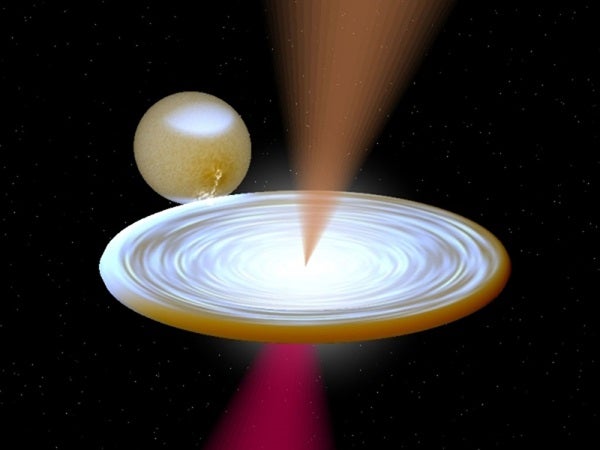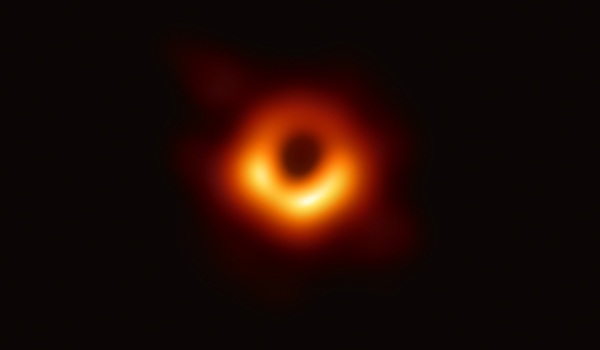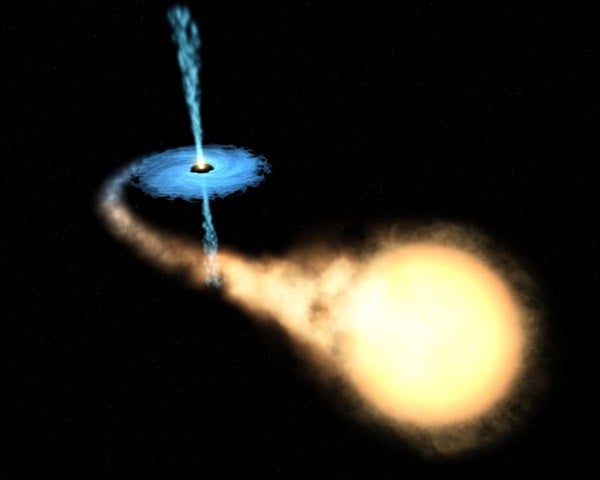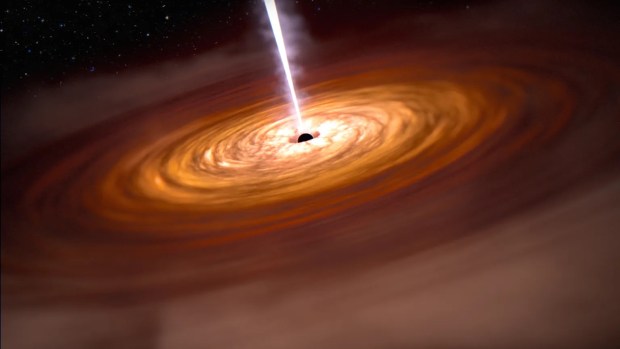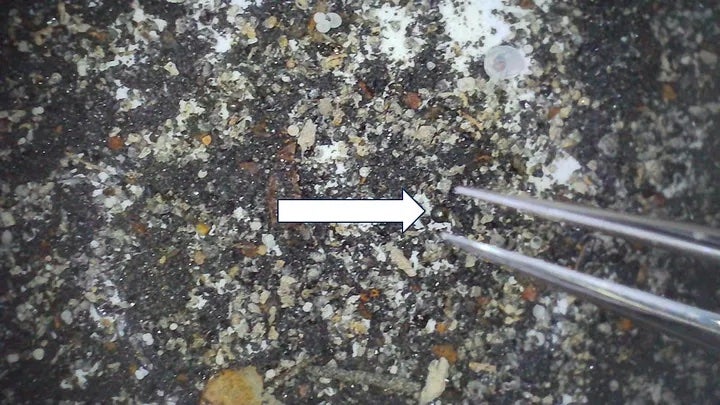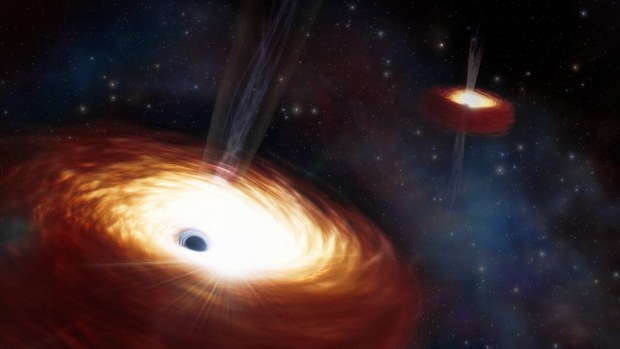So, one obvious question is: How much space do different types of black holes take up?
Black hole weight classes
The standard black hole, known as a stellar-mass black hole, forms when a massive star (greater than about 8 solar masses) reaches the end of its life. After depleting the last of its remaining nuclear fuel, the star’s uncontested gravity causes it to rapidly collapse before rebounding outward in an epic blast known as a supernova. What remains, depending on the mass of the star, will either be a neutron star or a black hole. These stellar-mass black holes can range from a couple to several dozen times the mass of the Sun.
However, the origins of supermassive black holes like Sagittarius A*, which can range from millions to billions of times the mass of the Sun, remain unknown. Astronomers do know their extreme size and mass seems to be related to the galaxies they call home, with the biggest supermassive black holes found in the centers of the biggest galaxies.
This line of evidence — as well as recent evidence for a theorized class of mid-sized black holes called intermediate-mass black holes (which range from hundreds to a million solar masses) — seems to suggest that supermassive black holes might get their heft after countless stellar-mass and intermediate-mass black holes merge together over the eons.
And although it’s clear that different types of black holes can dramatically vary in mass, it’s less obvious how much they vary in size.
What if Earth and the Sun were black holes?
To explore the sizes of black holes, let’s first start by looking at two objects that we’re more familiar with: Earth and the Sun.
Earth has a mass of some 6×1024 kilograms. And though that’s more massive than any human can truly comprehend, when it comes to black holes, Earth is puny.
To create a black hole, you need enough mass that the object’s gravity overcomes any outward forces preventing it from total collapse. This is why there are no known black holes as light as Earth — they just wouldn’t have enough mass to completely collapse. (However, some scientists think there could be a class of ancient primordial black holes forged in the first few moments after the big bang. These theoretical black holes could range from less massive than a paperclip to tens of thousands of times the mass of the Sun.)
At the center of a black hole is believed to be an infinite gravitational well in the fabric of spacetime, called a gravitational singularity. This singularity is infinitely dense, and anything that reaches it is stuck there for good. The outer edge of the black hole, called the event horizon, is the boundary beyond which nothing can escape the gravitational pull of the black hole, including light. Where this event horizon starts depends on the mass of the black hole and was first calculated by German astronomer Karl Schwarzschild in 1916.
Using the Schwarzschild radius calculation, a black hole the size of Earth would have a radius of less than one inch, making it about as big as a ping pong ball. The Sun, on the other hand, would have a radius of just under two miles.
What are the smallest known black holes?
Black holes are notoriously difficult for scientists to find. This is because, unlike stars, light that falls within a black hole’s event horizon will never be seen. However, sometimes a black hole has an accretion disk — a halo of material around the black hole that glows as it violently grinds together. The light emitted from such accretion disks makes it possible for scientists to find these otherwise invisible objects. Astronomers also spot black holes by noticing how they affect other objects, including stars. For instance, scientists discovered Sagittarius A* after spotting the odd behavior of seven stars orbiting it.
With these methods, scientists have found many black hole candidates over the years, including the smallest known black hole located in a binary system called GRO J1655-40. The visible companion star in this system is dumping gas onto the black hole, generating enough energy to power a microquasar.
Quasars develop in extremely luminous active galactic nuclei, which are the centers of galaxies hosting a supermassive black hole that is surrounded by a bright and energetic accretion disk. The black hole in GRO J1655-40 is estimated to weigh about 5.4 times the mass of the Sun, which would give it a radius of about 10 miles. By studying microquasars such as this, astronomers hope to better understand the possible link between the monsters lurking in galactic cores and smaller, accreting black holes spread throughout galaxies.
In 2008, scientists believed they had found an even smaller black hole, but the mass was later corrected by the same team. Any smaller black holes would likely be due to the merger of two neutron stars rather than the collapse of a dying star. The Laser Interferometer Gravitational-Wave Observatory detected gravitational waves from a possible neutron star merger in 2017, just two years after detecting gravitational waves for the first time. Gravitational waves emitted during mergers provide a new way for scientists to identify black holes within 100 million light-years of Earth.
On the other end of the spectrum, the size of a stellar-mass black hole depends on how massive the original star was. The most massive star found to date is R136a1 and weighs in at 315 times the mass of the Sun. If it stayed at its current mass, the resulting black hole from its inevitable collapse would have a radius of some 578 miles. Although large compared to the smallest known black holes, even this hefty stellar-mass black hole pales in comparison to its supermassive cousins.
How big are intermediate-mass black holes?
Between stellar-mass black holes and supermassive black holes are intermediate-mass black holes: a long-sought “missing link” in black hole evolution. Only a few intermediate-mass black hole candidates have been found to date, including one found by the Hubble Space Telescope earlier this year. These objects are even more difficult to find because they tend to be less active without nearby “fuel” to gobble up.
The recent black hole Hubble found is over 50,000 times the mass of the Sun. Discovered in a distant, dense star cluster on the outskirts of a larger galaxy, it was precisely where astronomers expected to find evidence for these “missing links.” At tens of thousands of solar masses, the intermediate-mass black hole candidate would still only have a radius one-fifth that of the Sun, or about twice the radius of Jupiter.
And while significantly big, intermediate-mass black holes only range from about 100 to 100,000 solar masses. Meanwhile, supermassive black holes can reach up to billions of times the mass of the Sun.
Sizing up supermassive black holes
Located 26,000 light-years from the Sun, our galaxy’s central black hole, Sagittarius A*, has a radius about 17 times that of the Sun, meaning that it would sit well within Mercury’s orbit. And though it weighs in at about 4 million solar masses, the Milky Way’s black hole is small compared to some of the other supermassive black holes lurking at the center of other galaxies.
The most massive supermassive black hole discovered to date lies within the Abell 85 galaxy cluster. At the heart of this cluster is the galaxy Holm 15A, home to an estimated 2 trillion solar masses. The very center of this galaxy is almost as large as the Large Magellanic Cloud, which has a radius of 7,000 light-years.
700 million light-years from Earth, this cluster was twice the distance of any previous black hole measurement when the Ludwig-Maximilians-University’s USM Wendelstein Observatory and the European Southern Observatory’s Very Large Telescope began collecting data. They found that the black hole at the center of Holm 15A clocks in at colossal 40 billion solar masses, or roughly two-thirds the mass of all the stars in the Milky Way. At that mass, it has a diameter the size of the entire Solar System, an astounding size for any single object to have.
But the observable Universe is 46.5 billion light-years in any direction, meaning astronomers have only scratched the surface of black hole observations. It was only a year ago that the Event Horizon Telescope, consisting of eight telescopes located around the world, released the first image of a black hole. Furthermore, the LIGO-Virgo gravitational-wave collaboration is predicted to detect some 40 binary star mergers every year moving forward thanks to new upgrades, uncovering nearby black holes and neutron stars like never before. And with new telescopes, such as NASA’s James Webb Space Telescope and ESO’s Extremely Large Telescope, set to achieve first-light within the next decade, there is no way to tell how many massive monsters scientists will find lurking in the darkness of space in coming years.

